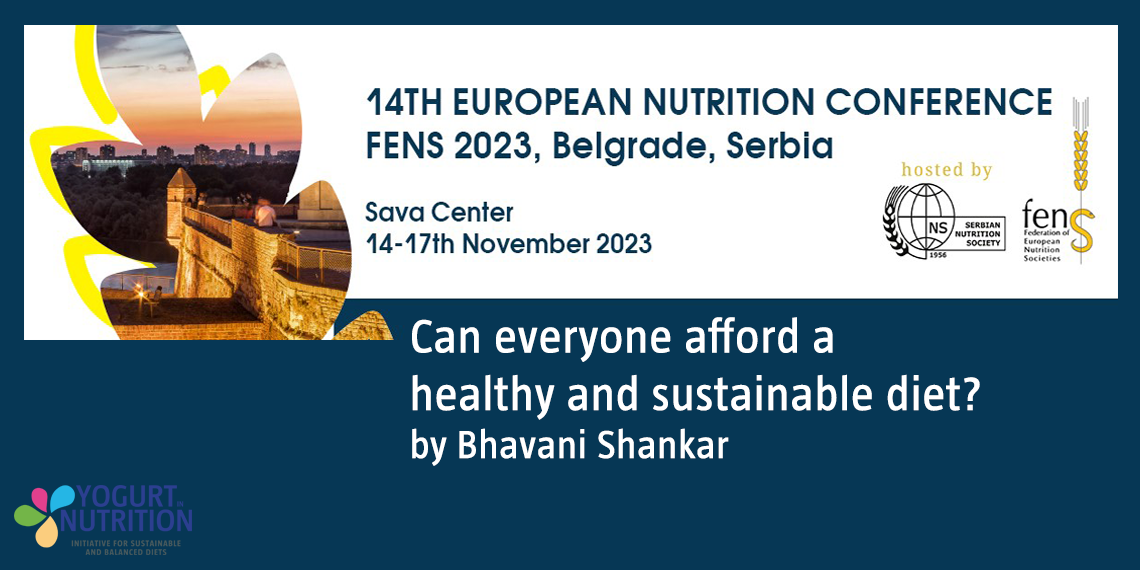The 14th European Nutrition Conference (FENS) took place in November in Belgrade, and we were there to cover and share with you some insightful topics.
In the “Nutrition and the Environment, Sustainability, and Biodiversity” sessions, Dr. Bhavani Shankar from the University of Sheffield, UK, addressed the critical question: ‘Can everyone afford a healthy and sustainable diet?’
“Can Everyone Afford a Healthy and Sustainable Diet?”, briefly
Poor diets significantly contribute to the global burden of disease, and current dietary patterns pose negative environmental implications.
The challenge lies in enhancing diets to benefit both human health and the health of the planet.
A healthy diet meeting WHO norms can reduce greenhouse gas emissions by 17%. However, achieving further emission reductions necessitates additional decreases in meat, dairy, and soft drinks consumption, coupled with increases in vegetables, beans, pulses, and nuts.
Historically, the primary focus has been on health aspects, including WHO dietary norms and specific health outcome targets. The recent shift towards reference diets aims to address both health and sustainability through restricted categories of foods (e.g., vegetarian, vegan, flexitarian, pescatarian) and diets like the EAT-Lancet diet.
The affordability of sustainable diets poses a significant question:
- Ensuring sufficient energy intake at low cost is a priority for lower-income consumers and countries.
- Many key food groups for healthy and sustainable diets are expensive sources of calories (e.g., fruits and vegetables).
- Conversely, some less healthy food groups are cheaper sources of calories (oils, fats, sugar).
- In lower-income countries, nutritious foods are often more expensive than in higher-income countries.
When assessing the affordability of the EAT-Lancet diet, it becomes evident that for 1.58 billion people, mainly in lower-income countries, even the lower bound planetary health diet exceeds total income. Fruits and vegetables account for the highest proportion of diet costs globally (31%), followed by animal source foods (28%), and legumes and nuts (19%). On average, the EAT Lancet diet is 60% more costly than a diet that simply meets essential nutrient requirements.
Key Messages :
- Environmental co-benefits from healthier diets present a real opportunity for action.
- The global relative costs of nutrient-dense foods, especially in low-income countries, are high.
- Integrating sustainability considerations alongside health aspects increases diet costs.
- Many people, particularly in low-income countries, cannot afford sustainable healthy diets.
- Challenges also exist in high-income countries, particularly for low-income households.
Dr. Bhavani Shankar’s insights highlight the intricate balance needed to make healthy and sustainable diets accessible to all, emphasizing the economic challenges.
Learn more with Bhavani Shankar
Hello, can you introduce yourself?
Bhavani Shankar: Hi, I’m Bhavani Shankar, a professor of food systems, nutrition, and sustainability. I work as an applied economist at the University of Sheffield in the UK, engaging in interdisciplinary research that spans food systems, nutrition, and various related fields.
What are the limits to making a sustainable diet accessible and affordable to all?
Bhavani Shankar: There are several barriers, particularly when viewed through an economic lens.
The relative prices of nutrient-dense foods, such as animal source foods or fruits and vegetables, are often prohibitively high in low-income settings.
We have to take them from a situation of being a luxury to being something that’s affordable in a mainstream way to all the people. Nutrition and diet quality cannot be a rich person’s indulgence. It has to be something that’s accessible to all.
And I think that we can elaborate all the possible diets that will meet planetary and health aspects. But until we get people to move towards those diets, it’s very difficult, and there’s an economic aspect to it.
Overcoming this challenge involves addressing economic, behavioral, and knowledge-related difficulties that people face in understanding and adopting sustainable diets.
You talk about working in an interdisciplinary team. Why is it important to work with others and to work together?
Bhavani Shankar: It is crucial because food consumption and food systems inherently involve multiple disciplines. As an economist, I might analyze income and prices, but understanding behavioral change and knowledge barriers requires collaboration with psychologists, food scientists, and food technologists. Different disciplines have distinct languages and methodologies, making interdisciplinary teamwork essential for tackling complex issues like sustainable food systems.
At the end of your presentation, you presented some solutions. What were they?
Bhavani Shankar: To make nutritious diets available to everyone, we need income support for the poorest individuals, as their lack of income is a major hurdle to accessing expensive yet nutritious diets Another aspect is to lower the prices of nutrient-dense foods. We need to make them cheaper somehow, and to do so, we can, for example:
- invest in agriculture and horticulture related to these nutrient dense foods.
- develop more R&D in these areas, not only focused on wheat, maize and rice but actually think about nutrient dense foods, like fruits and vegetables or dairy for example
- develop infrastructure in order to have less food waste, because the most nutritious foods are also the most perishable ones and it spoils very quickly. Unless you have the infrastructure, the block chains and the market capacity to handle these foods, you will lose a lot of food. This keeps the prices high and the availability low.
Bhavani Shankar’s current research interests include sustainable diets, climate and nutrition-sensitive food systems, food and nutrition policy evaluation and inequities in food systems and nutrition. Much of his work is of an interdisciplinary nature, conducted in collaboration with nutritionists, geographers and health, agricultural and environmental scientists.



